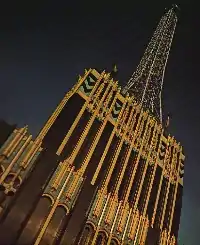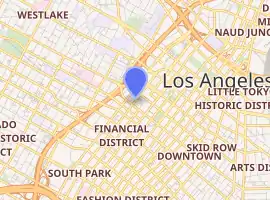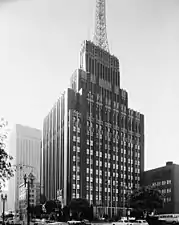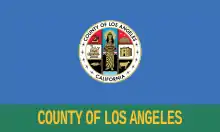Richfield Tower
Richfield Tower, also known as the Richfield Oil Company Building, was constructed between 1928 and 1929 and served as the headquarters of Richfield Oil in Los Angeles, California.
| Richfield Tower | |
|---|---|
 | |

| |
| General information | |
| Status | Demolished |
| Architectural style | Art Deco |
| Address | 555 South Flower Street |
| Town or city | Los Angeles, California |
| Country | United States of America |
| Coordinates | 34.050799°N 118.256966°W |
| Construction started | 1928 |
| Completed | 1929 |
| Demolished | November 12, 1968[1] – spring 1969[2] |
| Cost | $1,750,000 |
| Client | Richfield Oil Co.[2] |
| Height | 372 feet (113 m) |
| Technical details | |
| Structural system | Steel skeleton |
| Floor count | 12 |
| Design and construction | |
| Architect | Stiles O. Clements |
History
It was designed by Stiles O. Clements and featured a black and gold Art Deco façade. The unusual color scheme was meant to symbolize the "black gold" that was Richfield's business. Haig Patigian did the exterior sculptures.[1] The building was covered with architectural terra cotta manufactured by Gladding, McBean, as was typical of many west coast buildings from this era. In an unusual move, all four sides were covered since they were all visible in the downtown location.
The 12-floor building was 372 feet (113 m) tall, including a 130-foot (40 m) tower atop the building, emblazoned vertically with the name "Richfield". Lighting on the tower was made to simulate an oilwell gusher and the motif was reused at some Richfield service stations.[1]
The company outgrew the building, and it was demolished in 1969, much to the dismay of Los Angeles residents and those interested in architectural preservation, to make way for the present ARCO Plaza skyscraper complex. The elaborate black-and-gold elevator doors were salvaged from the building and now reside in the lobby of the new ARCO building (now City National Tower).[3]
The central figures of the Tympanum (Navigation, Aviation, Postal Service and Industry) over the main entry were donated by the Atlantic Richfield Company to the UC Santa Barbara Art & Design Museum, negotiated by Professor David Gebhard, noted UCSB architectural historian. He published a small illustrated volume on the building before demolition: The Richfield Building 1928–1968. Atlantic Richfield Co., Santa Barbara, 1970. After languishing in university storage for over a decade, three of the four figures were mounted outside the UCSB Student Health Center in 1982[lower-alpha 1]. The fourth figure was incomplete and remains in storage.
Richfield Tower was starkly featured in a few scenes of Michelangelo Antonioni's 1970 film Zabriskie Point, shot shortly before its demolition.
Gallery
.jpg.webp) Colored postcard, before 1945
Colored postcard, before 1945 North side and east front of building, 1968
North side and east front of building, 1968 Front detail
Front detail- Terracotta figures at the side
- Terracotta angel, closeup
- East entrance
.png.webp) Layout
Layout West side of building during demolition, April 1969
West side of building during demolition, April 1969
See also
 Greater Los Angeles portal
Greater Los Angeles portal
Explanatory notes
- 34°24'56.47" N 119°51'08.39" W
References
- "Richfield Oil Company Building". Pacific Coast Architecture Database. University of Washington. Retrieved December 10, 2017.
- "Richfield Oil Building, 555 South Flower Street, Los Angeles, Los Angeles County, CA". Historic American Buildings Survey. Library of Congress. Retrieved December 10, 2017.
- Harrison, Scott (June 13, 2016). "A beloved L.A. tower — and the winged 'army' that stood guard — is gone but not forgotten". Los Angeles Times. Retrieved March 21, 2017.
Further reading
- Felton, Dave (April 10, 1969). "Building's 'Guards' Now Lie Strewn in Wrecking Yard". Los Angeles Times. p. C1.
- Gebhard, David (1970). The Richfield Building, 1928–1968. Santa Barbara: Atlantic Richfield Co. ASIN B0007HRZ6S.
- Hebert, Ray (March 9, 1967). "Plaza Complex Slated for Richfield Block". Los Angeles Times. p. B1.
- Hebert, Ray (August 18, 1967). "Admirers Would Save 1929 Richfield Building". Los Angeles Times. p. A6.
- "Downtown Structure to be Guide". Los Angeles Times. August 25, 1929. p. E2.
- "Oilman Killed in Plunge from 12th Floor Office". Los Angeles Times. August 30, 1950. p. 17.
- "Crews Move In to Dismantle Landmark Richfield Building". Los Angeles Times. November 13, 1968. p. A1.
- "A Backyard Cheops Visits His Pyramid". Los Angeles Times. April 19, 1970. p. E1.
- Weaver, John D. (April 18, 1971). "The Miracle of Sixth and Flower". Los Angeles Times. p. P9.
External links
 Media related to Richfield Oil Company Building at Wikimedia Commons
Media related to Richfield Oil Company Building at Wikimedia Commons
_edit1.jpg.webp)